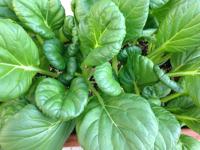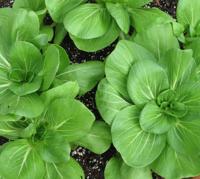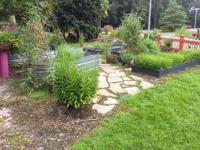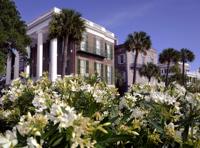“Leafy brassica greens” is the name of a large group of related vegetables in the cabbage family. They are excellent choices for fall vegetable gardens because they appreciate the cool fall weather. The seedlings are remarkably heat tolerant, so August is the time to start these crops from seed.
Many leafy greens are excellent sources of vitamins C and A. Some, like kale, supply calcium and vitamin B6. Arugula is high in vitamin K.
Leafy brassica greens fall into three broad groups. Collard and kale are in the Brassica oleracea group. Kale is further divided into green curly kale; red kale with reddish petioles and smooth leaves; and Tuscan kale, with long, slender, dark blue-green leaves.
Mustards, both traditional southern, broadleaved mustard greens and Asian mustards with a variety of leaf shapes, are in the Brassica juncea group. Tat soi with “spoon-shaped” leaves and mizuna with finely divided leaves (like celery) are two common Asian varieties. Of the three groups, mustards have the spiciest flavor.
Turnip greens and bok choy (also written as pak choi) are the two main subgroups in the Brassica rapa group. “Leaf turnips” often do not produce an edible root, like “root turnip” varieties.
Although collard and bok choy leaves tend to cluster together into a loose head, they are still called leafy brassicas.
Finally, arugula (Eruca sativa) is in the brassica family but doesn’t fit into any of these three groups. It’s what my mother would call a “shirttail cousin.”

Tat soi mustard is cold-tolerant enough to grow over winter. Anthony Keinath/Provided
Leafy greens
As in any large family, some members (plants) have nicknames that hide their identities. One of my favorite greens is called Tendergreen Mustard or “spinach mustard,” but it’s not a mustard, it’s a turnip.
Note that many other leafy vegetables aren’t members of the brassica family. These include head and leaf lettuce, spinach and Swiss chard, among others.
South Carolina is one of the leading U.S. states in production of leafy brassica greens. The industry is centered in and around Lexington County. Several thousand acres of greens help make Lexington the leading S.C. county in vegetable production.
According to Justin Ballew, Clemson commercial horticulture Extension agent in Lexington and Saluda counties, two favorite collard varieties among Lexington County growers are Tiger and Top Bunch 2.0. Both varieties are hybrids, which makes them very productive. They are available in home garden-sized seed packets from several companies.
Basic growing instructions can be found in Clemson’s Factsheet HGIC 1307, Collards, at bit.ly/ClemsonCollards. All leafy brassica greens can be direct seeded in the fall. Collard, kale and bok choy transplants are available for sale, but arugula, mustard and turnip are almost always grown from seed.

Bok choy "Bonsai Hybrid" is small enough to grow in a pot. Anthony Keinath/Provided
Pests and diseases
A common insect pest on greens in home gardens is the cross-striped cabbageworm, according to Zack Snipes, Clemson commercial horticulture extension agent in Charleston and Beaufort counties. This small worm with one long back stripe, one long yellow strip and many small cross stripes can eat large holes in leaves. To control this insect and others, see newly updated Factsheet HGIC 2203.
I have seen aphids on the undersides of brassica leaves at home. Aphids can be managed with insecticidal soap, but it normally takes two sprays to get all of them, as they hide under the curved edges of leaves or in the center of the plant to avoid the spray.
Mustard and turnip are more closely related to each other than either one is to collard or kale. This means, for instance, that mustard and turnip tend to get several leaf spot diseases, like Cercospora leaf spot and white spot, that don’t show up on collard and kale.
On the other hand, collard and kale are more likely to get black rot and downy mildew than mustard or turnip. These two diseases have been found on transplants offered for sale, so buyers should not purchase any plants with black or yellow spots on the leaves.
Downy mildew can be managed with potassium phosphite or copper products. Plants with black rot should be destroyed, as there is no practical control.
To manage leaf spots, all crops can be sprayed with biopesticides that contain Bacillus, a beneficial bacterium, as the active ingredient. Gardeners who have seen leaf spots in past years should spray crops before they see spots this year.
Leafy brassica greens deserve a spot in everyone’s fall garden.
"vegetable" - Google News
August 16, 2020 at 01:00AM
https://ift.tt/30XsqkQ
Gardening: Plant these greens for fall vegetable gardens - Charleston Post Courier
"vegetable" - Google News
https://ift.tt/2CyIOeE
https://ift.tt/3aVzfVV
Bagikan Berita Ini

















0 Response to "Gardening: Plant these greens for fall vegetable gardens - Charleston Post Courier"
Post a Comment